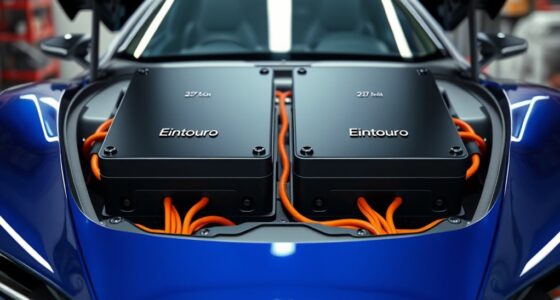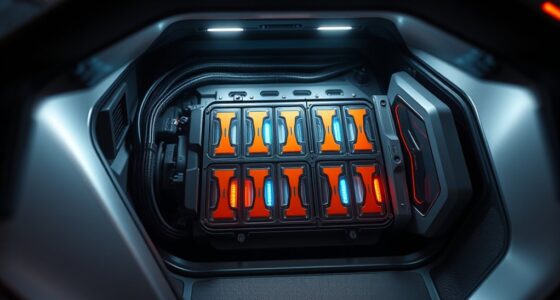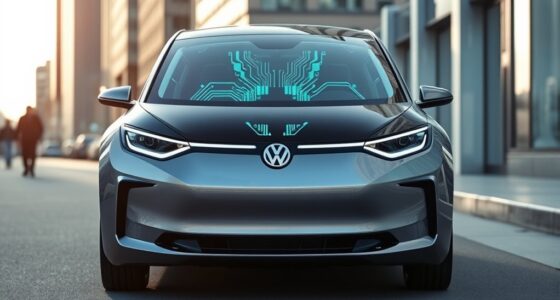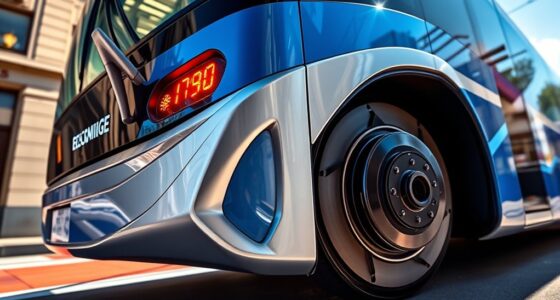Your electric bus’s daily range depends on factors like battery capacity, terrain, and driving habits. Larger batteries store more energy, boosting distance, but hilly roads or aggressive driving can reduce it. Environmental conditions like cold weather or wind also play a role. To optimize performance, consider route planning based on terrain and monitor battery health regularly. Understanding these influences helps you plan better, and if you keep exploring, you’ll uncover how to improve your bus’s efficiency even further.
Key Takeaways
- Battery capacity directly influences the maximum achievable range of an electric bus.
- Terrain type, such as hills or flat roads, significantly impacts energy consumption and range.
- External factors like driving style, weather, and wind conditions alter actual daily travel distance.
- Real-world testing and data provide more accurate range estimates than theoretical calculations.
- Operational planning should consider terrain, weather, and battery health to optimize daily bus routes.
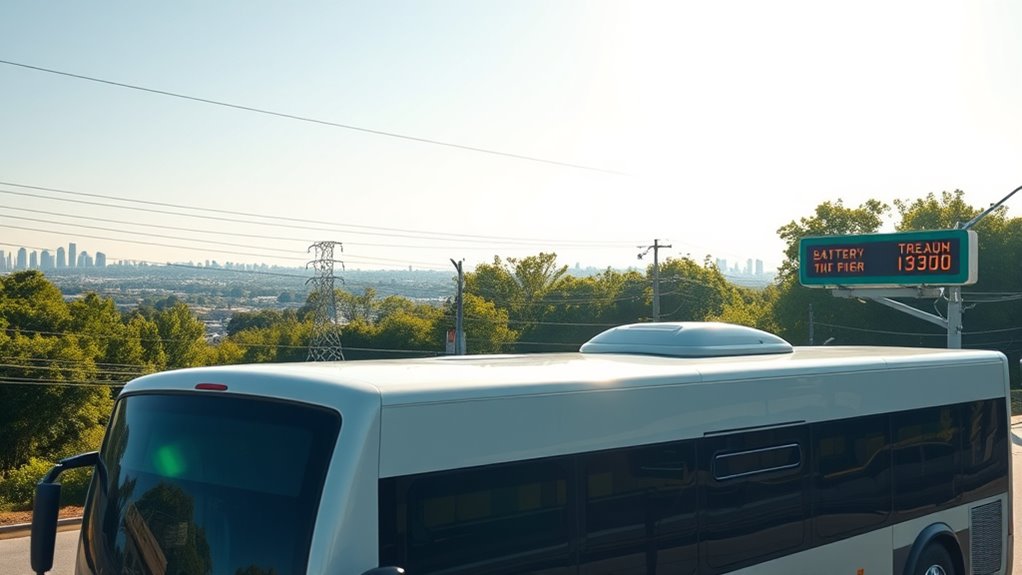
Have you ever wondered how to accurately determine the distance a vehicle or projectile can travel? When it comes to electric buses, understanding the factors that influence their range is essential for efficient planning and operation. One of the most significant factors is battery capacity. The larger the battery, the more energy it can store, which directly translates to a longer travel distance. Modern electric buses often feature high-capacity batteries designed to maximize range, but even the most advanced batteries have limits. Knowing the battery capacity helps you predict how far the bus can go on a full charge, which is critical for scheduling routes and avoiding unexpected downtime. Keep in mind, however, that battery capacity isn’t the only element at play. The terrain influence also plays an important role in range calculations. Flat, smooth roads require less energy, allowing the bus to travel further on the same charge. Conversely, hilly or uneven terrain demands more power, reducing the overall range. Uphill climbs force the electric motor to work harder, consuming more energy, while downhill stretches might recover some energy through regenerative braking. Hence, understanding the terrain where the bus will operate helps in creating realistic range estimates and adjusting routes accordingly. You should also consider other factors that interact with battery capacity and terrain influence, such as driving behavior—aggressive acceleration or high speeds drain the battery faster—and environmental conditions like temperature, which can impact battery efficiency. For example, cold weather can reduce battery performance, decreasing the distance the bus can travel. Wind resistance can also be a factor if the bus faces headwinds, requiring extra energy to maintain speed. When planning routes or evaluating a bus’s range, it’s essential to account for these combined effects. Using real-world data and testing under typical operating conditions is the best way to obtain accurate estimates. Remember, theoretical maximum range often differs from practical range, especially when terrain and external factors come into play. Understanding how to incorporate all relevant factors helps in creating more precise range predictions and optimizing operational efficiency. By understanding how battery capacity and terrain influence range, you can better plan for daily operations, prevent unexpected disruptions, and optimize the use of your electric fleet. Regularly monitoring battery health and adjusting routes based on terrain and weather conditions help maintain reliability and extend the overall lifespan of your buses. Effective range calculations aren’t just about numbers—they’re about ensuring your electric buses operate efficiently, safely, and reliably day after day.
Frequently Asked Questions
How Do Weather Conditions Impact Electric Bus Range?
Weather conditions impact your electric bus range significantly. Cold weather forces you to rely on battery thermal management, which consumes extra energy to keep batteries warm, reducing range. Hot weather can cause batteries to overheat, also affecting efficiency. Your driver behavior matters too—smooth acceleration and deceleration conserve energy, while aggressive driving wastes it. Both weather and driving style play essential roles in how far your electric bus can go daily.
What Maintenance Practices Extend Battery Life and Range?
To extend your electric bus’s battery life and range, regularly perform battery calibration to guarantee accurate readings and peak performance. Keep tire pressure at recommended levels to reduce rolling resistance, which conserves energy. Avoid deep discharges and always follow manufacturer guidelines for charging cycles. Proper maintenance not only prolongs battery health but also maximizes your bus’s daily operational range, saving you time and money.
How Does Passenger Load Influence Daily Travel Distance?
Ironically, passenger load often shrinks your bus’s daily distance, despite feeling busier. Heavier passenger weight and increased boarding frequency demand more energy to move, reducing range. When your bus is packed, it consumes more battery power, meaning less time on the road. So, the more passengers you carry, the shorter your route might be — a surprising twist for those expecting endless miles.
Can Route Planning Improve Overall Electric Bus Efficiency?
Yes, route planning can considerably improve your electric bus efficiency. By optimizing routes, you reduce unnecessary detours and energy consumption. Guarantee your drivers are well-trained to adopt energy-efficient driving techniques. Additionally, investing in a robust charging infrastructure allows quick turnaround times and maintains your fleet’s range. These combined strategies help maximize daily travel distances, reduce costs, and boost overall operational efficiency.
What Technological Advancements Are Expected to Increase Range?
You can expect technological advancements like improved battery chemistry, such as solid-state batteries, to substantially boost your electric bus’s range. Additionally, expanding charging infrastructure, including faster chargers and smart grid integration, will make recharging more efficient and convenient. These innovations will help you travel longer distances on a single charge, reducing downtime and increasing overall operational efficiency for your electric fleet.
Conclusion
By understanding these factors, you could potentially turn your electric bus into an unstoppable, all-day marathon runner that never runs out of juice. With the right planning, your bus might just conquer mountains of miles in a single day, leaving traditional buses in the dust. So, get ready to revolutionize your fleet—because mastering range calculations could reveal the secret to endless, worry-free electric bus journeys. The future of transportation is in your hands—make it legendary!


